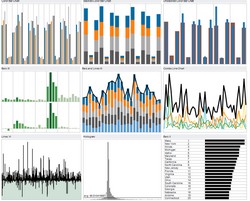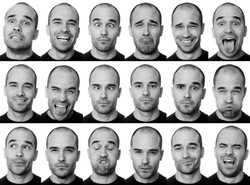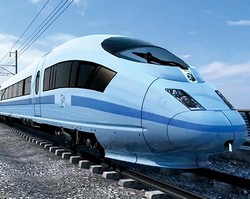28 October 2013
I spend the vast majority of my working life explaining to people why Tableau is the best tool on the market today for allowing business users to analyse data. In just about any context, with any size data, from any database, Tableau would be my tool of choice for making sense of data.Explaining just WHY this is the case, in just a few words can be difficult – so I often make use of metaphors to shorten the time it takes to explain the Tableau experience. I wanted to share two of these stories in the hope that others might share a few of theirs with me.And what of the world of 'digital' photography?
 Most visualisations built in Tableau take between 10 and 60 seconds to create, perspective switching is often instant and users can feel free to explore their data landscape without fear that there is a cost associated with each explorative step.Creating a visualisation in Tableau is very nearly cost free, and thus Tableau users feel free from the usual constraints associated with 'traditional' business intelligence projects.
Most visualisations built in Tableau take between 10 and 60 seconds to create, perspective switching is often instant and users can feel free to explore their data landscape without fear that there is a cost associated with each explorative step.Creating a visualisation in Tableau is very nearly cost free, and thus Tableau users feel free from the usual constraints associated with 'traditional' business intelligence projects.Traditional BI anyone?
You can of course have differnt types of train. You can improve the speed, make them more comfortable and make them cheaper, but in the end they are still trains and suffer from the serious problems described above.The software provided by traditional BI vendors represent different types of train. You can argue whether Qlikview is a little more comfortable than Business Objects for example, or whether Cognos is a little cheaper – but either way, developer led, IT centric software will always suffer from the same problems trains do.Expect very little new insight as the software simply isn't responsive enough to keep up the demands of the ever changing data landscape.
The 'Digital Photography' Metaphor
Remember 'Traditional' photography? Can you remember the experience of taking photographs with actual film?
I don't want to reminisce back to the glory days of photography and argue about the quality of images created with digital cameras today, that's not the point of this story – more importantly I want to think about COST.Taking pictures with film has a cost – the cost of the film itself, the cost of the development process and the cost of storing physical images. These issues are non-trival and they affected the way we took photos.- We rejected taking some photos in case they weren't worth the cost.
- We planned our photos more carefully hoping that the planning would result in a better outcome.
- Perhaps we enjoyed the process of taking photos less due to the likelyhood of wasting money.
- Certainly we can all remember being disapointed after collecting our photos – having waited a week for them to be created by a specialist.
And what of the world of 'digital' photography?
- We don't have to worry about storage much – we expect to store 10,000s of images on a commodity laptop or thumb drive.
- There is little risk associated with taking photo's that don't turn out to be any good.
- If you don't like the photos, just delete them, nothing lost.
- It's very nearly COST FREE to take digital photographs, and we can improve the quality of our output by trying the same thing many times.
What's this got to do with Tableau?
Tableau is the data analysis equivilent of digital photography. Most visualisations built in Tableau take between 10 and 60 seconds to create, perspective switching is often instant and users can feel free to explore their data landscape without fear that there is a cost associated with each explorative step.Creating a visualisation in Tableau is very nearly cost free, and thus Tableau users feel free from the usual constraints associated with 'traditional' business intelligence projects.
Most visualisations built in Tableau take between 10 and 60 seconds to create, perspective switching is often instant and users can feel free to explore their data landscape without fear that there is a cost associated with each explorative step.Creating a visualisation in Tableau is very nearly cost free, and thus Tableau users feel free from the usual constraints associated with 'traditional' business intelligence projects.- Less up front design is required, as mistakes are less costly
- Exploration of data leads to exciting new discoveries which couldn't have been made otherwise
- When you can easily explore your world, unemcumbered by slow, inflexible tools, work feels like play
The 'Helicopter' Metaphor
This is a story about the difference between 'IT Centric, Developer led' business intelligence and the modern class of data analysis tools that are being used by business users. It's a story about the difference between trains and helicoptors.Trains are fantastic. I'm on one now. They get you from one place to another very fast (in my case from London to Manchester in 2 hours) and in some degree of comfort. Some can be better than others.There are however some SERIOUS problems with trains.- Trains require a ludicrous level of up front design and planning – our new UK train line HS2 will be 20+ years in design…
- Trains almost never go exactly where I want them to – I want to go to my house, not the train station!
- It is very hard to make a train change direction when you need to go somewhere unexpected
- You will almost NEVER discover anything new whilst on a train – 'oh, looks there's a castle… oh no, it's gone…'
Traditional BI anyone? 
You can of course have differnt types of train. You can improve the speed, make them more comfortable and make them cheaper, but in the end they are still trains and suffer from the serious problems described above.The software provided by traditional BI vendors represent different types of train. You can argue whether Qlikview is a little more comfortable than Business Objects for example, or whether Cognos is a little cheaper – but either way, developer led, IT centric software will always suffer from the same problems trains do.Expect very little new insight as the software simply isn't responsive enough to keep up the demands of the ever changing data landscape.Now what if I had a helicopter?
- I would be able to whizz around looking at anything that caught my eye.
- I could easily change my point of view – losing height to look into the detail and pulling up to see the big picture.
- I could land any time I saw something interesting (say a castle) and walk around a little.
